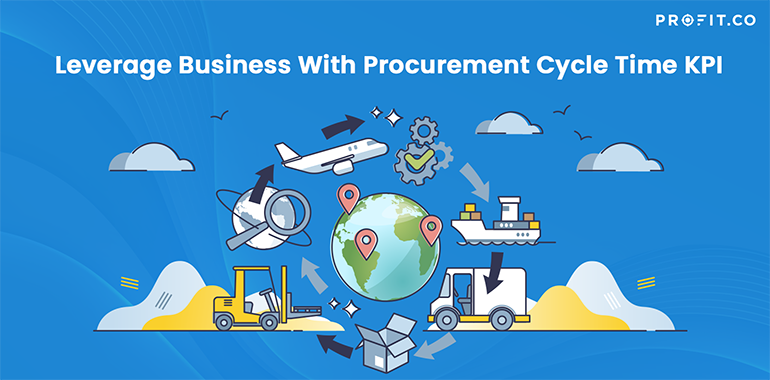Introduction
The procurement cycle is at the heart of any business, regardless of its size or industry. It refers to acquiring the necessary goods and services a company needs to meet its business goals. In this cycle, multiple steps are undertaken – from recognizing the need for a product or service to the final stage of paying the invoice associated with that acquisition. Managing this cycle effectively is crucial for efficiency and cost-saving. One way to do this is by using Key Performance Indicators (KPIs), and among the most critical of these is the Procurement Cycle Time.
See what the world says about procurement in this article on 5 Business Strategies For Procurement Leaders by Forbes
Finish reading this blog and get ready to see your supply chain in a whole new light! Let’s see what we got for you!
What is Procurement Cycle Time KPI?
Procurement Cycle Time KPI is a performance measurement that helps businesses determine how long it takes from the moment a procurement need arises until the process is complete. This includes steps such as purchase order creation, supplier communication, order delivery, and finally, invoice settlement.
The first rule of any technology used in a business is that automation applied to an efficient operation will magnify the efficiency. The second is that automation applied to an inefficient operation will magnify the inefficiency.
This KPI can provide valuable insight into the efficiency of a company’s purchasing operations. Shorter cycle times typically indicate a more efficient process, which can contribute to cost savings, improved supplier relationships, and better inventory management. Conversely, longer cycle times may mean bottlenecks, inefficiencies, or delays in the process that must be addressed.
Make every minute count, Efficiency begins right here
The Procurement Cycle Time KPI Formula
The formula for the Procurement Cycle Time KPI is simple but effective. It’s calculated by taking the total time spent on procurement activities over a certain period and dividing it by the total number of procurement cycles completed in that same period. The result gives you the average procurement cycle time.
Here is the formula:

Let’s understand this formula using an example
Example of Procurement Cycle Time KPI
Suppose your company has conducted 50 procurement cycles in July. You’ve kept track of the time spent on procurement activities and found that the total time spent is 250 hours.
Now, plug these numbers into our formula:
Procurement Cycle Time = 250 hours / 50 cycles
This gives you an average Procurement Cycle Time of 5 hours per cycle.
This information provides a baseline for your procurement processes and is the first step toward process improvement.
OKR Examples to Optimize Po Cycle Time
Objective and Key Result (OKR) is a popular framework that helps organizations set, track, and achieve their goals. Here are some examples of OKRs for Procurement Cycle Time, with initiatives that will help achieve the desired results.
Objective 1: Improve the Efficiency of Our Procurement Cycle
KR 1: Reduce the average Procurement Cycle Time from 5 to 3 hours per cycle by the end of Q4.
Initiatives: Implement a new procurement software to automate and streamline the procurement process.
KR 2: Reduce average supplier response time from 48 to 24 hours by the end of Q2.
Initiatives: Implement a Supplier Relationship Management (SRM) system to track and optimize supplier performance.
KR 3: Decrease procurement-related errors by 30% by the end of Q4.
Initiatives: Establish regular training and refreshers for procurement staff on best practices and avoiding common mistakes.
Why Does Procurement Cycle Time KPI Matter?
The faster your procurement cycle, the more efficient your business is. A shorter procurement cycle means less time waiting for products or services to arrive, resulting in quicker responses to market changes and more opportunities for growth. Let’s see what the shorter procurement cycle time can achieve.
-
Efficiency and productivity
Procurement Cycle Time KPI improves efficiency and productivity through targeted improvements.
-
Cost reduction
Reducing procurement cycle time saves costs and minimizes the risk of disruptions.
-
Improved supplier relationships
Fast and smooth procurement processes foster strong relationships with suppliers.
-
Competitive advantage
Short procurement cycle time provides a competitive edge by enabling faster responses and opportunities.
-
Risk management
Tracking and reducing Procurement Cycle Time helps mitigate supply chain risks.
-
Customer satisfaction
Efficient procurement processes enhance customer satisfaction by meeting demands promptly.
The Path Forward
Now that you understand the importance of the Procurement Cycle Time KPI, it’s time to implement this knowledge. Monitor this KPI closely, and don’t be afraid to make changes when needed. Remember, the path to an efficient procurement process lies in understanding your current performance and continuously striving for improvement.
Remember, every minute saved in a procurement cycle could translate into significant cost savings and efficiency gains over the long term. Keep the Procurement Cycle Time KPI at the forefront of your business strategy, and you’ll be well on your way to improved efficiency and profitability.

